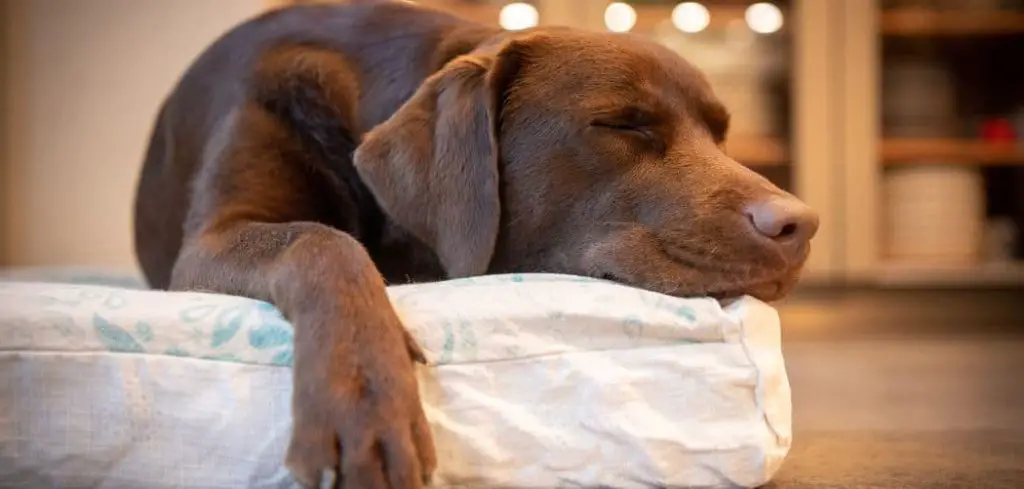Excessive paw licking combined with limping can indicate pain, discomfort, or injury in your dog.
While occasional licking and minor limping can occur after activity, persistent or worsening signs are a signal that something more serious may be affecting your pet.
We outline the common causes of a dog excessively licking its paw and limping, what you can do at home, and when to seek veterinary help.
Dog Excessively Licking Paw and Limping — Why It Happens
A dog excessively licking its paw combined with limping is often a sign of discomfort or injury. Common causes include cuts, foreign objects, infections, arthritis, or allergies. Environmental irritants, nail injuries, and behavioral factors may also contribute.
Dogs instinctively lick areas that are sore, itchy, or inflamed, and limping is a natural way to protect the affected limb.

Dog Excessively Licking Paw and Limping: Common Causes
Paw Pad Injuries
Cuts, abrasions, burns, or foreign objects like splinters or thorns can cause localized pain and discomfort.
Dogs lick injured paw pads to clean the area and soothe irritation, while limping protects the affected paw.
Signs include bleeding, redness, swelling, or visible foreign objects. Prompt cleaning, protective bandaging, and monitoring prevent infection and promote healing.
Read more: Dog Excessively Licking Paw Pad (Causes and relief tips)
Nail Problems
Overgrown, broken, or torn nails can make walking painful. Licking and limping are natural responses as dogs try to alleviate discomfort and protect the injured paw.
Look for broken nails, bleeding, or reluctance to put weight on a paw. Veterinary trimming or care may be needed to resolve the issue safely.
Allergies
Allergies can cause itchiness and inflammation in the paws, prompting repeated licking.
Dogs with paw allergies may also limp due to irritation or secondary swelling. Environmental allergens, such as grass, pollen, or chemical residues, or food allergies, may trigger this behavior.
Managing allergens, adjusting diets, and using veterinarian-approved medications can help reduce discomfort.
Infections
Bacterial, fungal, or yeast infections can affect paw pads and toes. Excessive licking is a dog’s attempt to soothe itching or pain, and limping may result from tenderness or swelling.
Infected paws may appear red, moist, foul-smelling, or have discharge. Veterinary care is essential for proper diagnosis and treatment with medications or topical therapies.
Arthritis or Joint Pain
Older dogs or those with joint issues may lick the paw nearest a painful joint. Licking can provide relief or distract from discomfort, while limping protects the affected limb.
Stiffness, reluctance to walk, or difficulty standing may accompany these signs. Veterinary guidance can provide pain management, supplements, and lifestyle adjustments to reduce limping and licking.
Foreign Objects or Irritants
Debris such as small stones, plant material, or ice can lodge between toes. Licking is a natural way for a dog to remove irritants, and limping protects the paw.
Redness, swelling, or visible foreign objects may be present. Removing debris carefully and monitoring for infection is important for recovery.
What to Do If Your Dog Is Excessively Licking Their Paw and Limping
Observe your dog to determine the severity and possible cause. Note when and how often licking occurs and which paw is affected.
Keep paws clean and dry. Rinse and gently dry paws after outdoor walks or exposure to dirt, chemicals, or allergens. This reduces irritation and the risk of infection.
Check for visible injuries. Examine paw pads, nails, and between toes for cuts, foreign objects, or swelling. Minor injuries may be cleaned and monitored at home, but persistent issues require veterinary care.
Provide temporary relief. Use protective booties, clean socks, or an Elizabethan collar to prevent excessive licking while healing occurs. Avoid harsh chemicals or ointments without veterinary approval.
Address underlying causes. Adjust diet, limit allergen exposure, or provide mental enrichment to reduce stress-induced licking if no visible injury is present.
Monitor mobility and comfort. Encourage gentle activity and avoid forcing exercise until pain or limping improves. Observation helps determine if symptoms are worsening or resolving.
When to Call or Visit Your Vet
Seek veterinary care if limping is severe, persistent, or accompanied by swelling, bleeding, or pus. Signs such as fever, lethargy, or refusal to bear weight indicate urgent attention.
Persistent or worsening licking that leads to open sores requires professional evaluation. Veterinarians can identify infections, injuries, or allergies and provide appropriate treatments. Early intervention prevents chronic irritation and complications.
Veterinary treatment may include imaging, medications, topical therapies, or surgical interventions in severe cases.
Professional guidance ensures effective management and reduces pain, helping your dog recover safely.
Read more: Dog Licking Paws Excessively (What it means and what to do)
Key Takeaway
Excessive paw licking combined with limping often indicates injury, infection, allergies, or joint pain. Observing your dog, maintaining paw hygiene, and addressing environmental factors are critical first steps.
Veterinary evaluation is essential if symptoms persist, worsen, or cause discomfort.
With careful observation, at-home care, and professional guidance, you can alleviate your dog’s paw pain, reduce licking and limping, and support their overall health and mobility.
Prompt attention ensures your dog remains happy, comfortable, and active.
